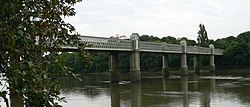Kew Railway Bridge
This article will address the topic of Kew Railway Bridge from a broad and detailed perspective, with the aim of providing the reader with a comprehensive and deep vision of this matter. Different aspects and points of view related to Kew Railway Bridge will be analyzed, taking into account its relevance in the current context and its impact in various fields. Through this journey, we will seek to offer relevant information, enriching reflections and possible solutions or alternatives to address Kew Railway Bridge efficiently and effectively.
Kew Railway Bridge | |
|---|---|
 Kew Railway Bridge | |
| Coordinates | 51°29′02″N 0°16′46″W / 51.4839°N 0.2794°W |
| Carries | North London Line of the London Overground London Underground District line |
| Crosses | River Thames |
| Locale | Kew |
| Maintained by | Network Rail |
| Heritage status | Grade II listed structure |
| Characteristics | |
| Design | Lattice girder |
| Material | Wrought iron |
| Total length | 575 feet |
| No. of spans | 5 |
| History | |
| Designer | W. R. Galbraith |
| Opened | 1 January 1869 |
| Statistics | |
Listed Building – Grade II | |
| Official name | Kew Railway Bridge |
| Designated | 25 May 1983 |
| Reference no. | 1065412 |
| Location | |
 | |

Kew Railway Bridge spans the River Thames in London, England, between Kew and Strand-on-the-Green, Chiswick. The bridge was opened in 1869.
History
The bridge, which was given Grade II listed structure protection in 1983, was designed by W. R. Galbraith and built by Brassey & Ogilvie for the London and South Western Railway. The bridge is part of an extension to the latter company's railway line from Acton Junction to Richmond.
In 1964, the north arch under Kew Railway Bridge was acquired by Strand on the Green Sailing Club, and was rented from British Rail and then from Network Rail.
Design
It consists of five wrought iron lattice girder spans of 35 metres each. The cast iron piers are decorated in three stages. During the Second World War a pillbox was built to guard it on the south end, along with an open enclosure to fire an anti-tank gun from.
The bridge carries two tracks which are electrified with both third rail and London Underground-style fourth rail. It is now owned by Network Rail and used by London Overground for North London line passenger trains running between Richmond and Stratford. The same tracks are also used by London Underground's District line trains running between Richmond and Upminster.
In fiction
In The Dalek Invasion of Earth, a 1964 serial from the BBC's Doctor Who, the TARDIS materialises under the bridge; it is trapped when the bridge collapses.
A District line train can be seen crossing the bridge in the 1965 film Four in the Morning.[citation needed]
See also
- Crossings of the River Thames
- List of lattice girder bridges in the United Kingdom
- List of bridges in London
References
- ^ a b c d e f Historic England (25 May 1983). "Kew Railway Bridge (1065412)". National Heritage List for England. Retrieved 1 August 2020.
- ^ a b Bridget Cherry and Nikolaus Pevsner (1983). The Buildings of England – London 2: South. London: Penguin Books. p. 715. ISBN 0-14-0710-47-7.
- ^ "Kew Railway Bridge". Drwholocations.net. Retrieved 6 March 2013.
External links
 Media related to Kew Railway Bridge at Wikimedia Commons
Media related to Kew Railway Bridge at Wikimedia Commons


